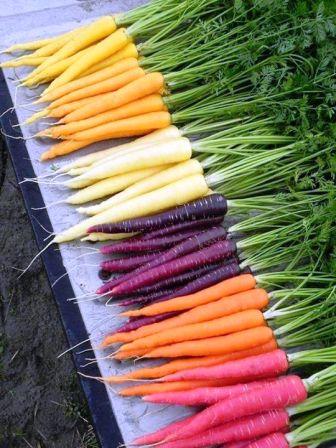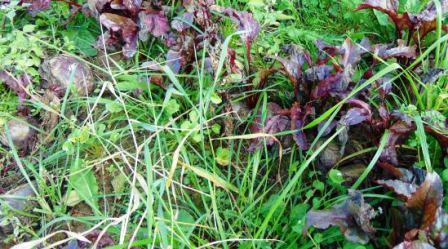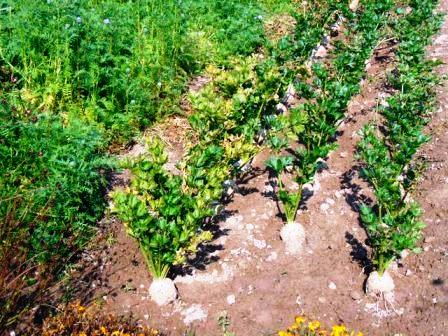In a loose, crumbly soil, you get long, straight and little branched roots. If they cannot freeze your roots (and tubers) keep long.
 Wild roots are found everywhere. They are usually thin, white, fibrous and not appetizing. But they are already very long cultivated in colors of purple and red to yellow and green to white.
Wild roots are found everywhere. They are usually thin, white, fibrous and not appetizing. But they are already very long cultivated in colors of purple and red to yellow and green to white.
The orange carrot was developed in the 17th century in the Netherlands. Some stories are linking the color to the royal family (The House of Orange(-Nassau)). The orange pigment of carrots (Daucus carota) is rich in carotene.
Carrots: the foliage is also edible.arrot and beetroot are roots.
Carrots are very good for your eyes.
In World War II pilot John Cunningham shot twenty opponents at night from the air. The Royal Air Force wrote his hawk eyes in their propaganda to eating carrots. To facilitate to keep secret the use of the newly developed radar. But it was believed. Because have you ever seen a rabbit with glasses?
Partly right a bit. Our body converts beta-carotene into vitamin A, which is good for the eyes, but little significant. Prolonged and severe vitamin A deficiency can cause xerophthalmia or dryness of the eyes and night blindness.
The aboveground part of the root can be green and bitter.
With trade names from the distribution is created a non-existent difference (in the Netherlands) between bundle carrots: carrots with tops that are tied together in a grove, and wash carrots: who has no leaves and is washed. The canning industry also produces delicious small carrots. Habitually roots that were already cut at harvesting in equal parts, and then tumbled to round off the corners.
Sugar carrot (plated carrot, Sium Sissarum) was possible already known to the Romans. He was re-introduced in Europe in 1546. Sweet goody was luxury at that time.
Sugar root can be a half meter tall and forms clusters of elongated roots, about 15 to 20 centimeters long and one finger thick, with a white core. It is a hardy perennial plant. Young leaves can be bleached in the spring and eaten. The roots contain 6 to 8% sugar and can be harvested from the fall of the 2nd year. In the summer, take the panicle out because that reduces the quality of the roots. After the harvest, you can plant the central pole again.
Clean the roots with a soft brush, and prepare them as salsify.
Turnip-rooted parsley (Petroselinum crispum var. Tuberosum) has up to 15 cm long and 5 cm thick white taproot resembling parsnips and celeriac. The leaves can be used in the same way as parsley. The roots can overwinter in the soil or be harvested.
Rampion (bellflower) (campanula rapunculus) is a member of the family that has small bell flowers, white root to 2 cm wide and 7-8 cm long. The plant is hardy. The young leaves can be used in salad (tastes like lamb's lettuce).
Beet seeds are with 3 to 5 pieces in a cork-like tangle. Therefore, thinning (or ’set 1 on 1') is needed, because otherwise too many plants sit together (which can cause leaf spot). Besides multigerme races there are now (for mechanized seeding) also monogerme races where only one seedling comes from a seed tangle.
The beet (Beta vulgaris) is a member of the amaranth family (Amaranthaceae) and the genus beet (Beta). They can be white, yellow or red (ish).
Sugar beet (Beta vulgaris subsp. Vulgaris var. Altissima) contains about 16% sugar
Fodder beet (Beta vulgaris subsp. Vulgaris var. Crassa) is used as animal feed
Chard (Beta vulgaris subsp. Vulgaris var. Vulgaris) is a leaf vegetable that has no thickened root. Red beet (Beta vulgaris subsp. Vulgaris var. Ruba) we know as a vegetable. She is grated raw, cooked or pickled. Also seedlings of beetroot (beet sprouts) are eaten. Anthocyanin colors the flesh striking red purple.
Red beet (Beta vulgaris subsp. Vulgaris var. Ruba) we know as a vegetable. She is grated raw, cooked or pickled. Also seedlings of beetroot (beet sprouts) are eaten. Anthocyanin colors the flesh striking red purple.
Pickling in sweet and sour:
Leave 1 cm. leaves to the root against the bleeding. Boil the whole beets.
Boil half vinegar and water with a few cloves, bay leaf, peppercorns, and some sugar (to taste) in half. Peel the beetroot (best wear gloves) and cut them in cubes or slices. Put them into hot jars and pour the cooked-hot vinegar on it.
With as reference the bottom surface, grows above it beetroot; sugar beet almost all the way in; and fodder beet half in.
Fodder beet or mangold is up to 60 cm long and has pale yellow to white flesh. You can keep them easy and safe (silage) as winter feed. Also, the leaves are fine feed!
In 1845 tests were done in Gelderland with rye bread, which consists half of mangold. They are first peeled, then grated and squeezed, "so that remaining solids in weight are approximately half, the pressed beet is then with a quantity of rye flour... "
Mangold is also used as a raw material for distilleries.
And long before Halloween was imported from America, they have been eroded, and provide a face, lit with a candle.
A mangle roll is a press system which was used for the simultaneous removal of moisture from the washed fabric and ironing plane. But that has nothing to do with the word mangold, which quite possibly refers to a kind of sorrel.
The leaves of Swiss chard are eaten like spinach leaves, the stems eaten as a kind of asparagus.
Chard is another word for it and would be a slightly different variety with thinner roots and especially thick broad leave stems.
Parsnip is a nutritious white root, see <Hardy vegetables and Belgian endive>
The (Black or Spanish) salsify (Scorzonera hispanica) 'winter asparagus' (or 'poor man's asparagus") is a typical winter vegetable with a delicious black carrot that can be 30 to 60 cm long. They give sticky latex stains on your hands when you’re peeling them. They are usually peeled (with gloves) underwater and preserved with vinegar.
I cook them with skin. Rinse in cold water and then squeeze the root of the shell or poaching.
Purple salsify, goatsbeard or vegetable oyster (Tragopogon porrifolius) is a little used white salsify-alike. Purple Morning is also called poor man's asparagus, white salsify and oyster.
The plant has grass or leek -like leaves and is frost resistant. The leaves can be used in salads or prepared like spinach.
Roasted roots can be used as a coffee substitute.
The sweet-tasting, milky sap of the root is very nutritious. The roots are peeled underwater, because of the sticky and browning latex.
Purple salsify contains 15 to 20% inulin, a good substitute for fat, low in calories. Inulin does not rise the blood sugar and is therefore valuable for diabetics.
Purple salsify is supplanted by salsify with which he has a lot of similarities.
Chicory is a relative of chicory family and endive, and known as a coffee substitute. (see < Coffee substitute > and <Edible rootss>)
(Fodder or oil) Radish (Raphanus sativus subsp. Niger) (or long black winter radish) is a cruciferous (cabbage) tuber that resembles
radish (Raphanus sativus subsp. sativus) which is more a stem tuber. Black radish is longer and has a milder flavor, is firmer and bigger. The flesh is white, the skin may be white, red, blue, black brown, black or yellow.
Radish (Raphanus sativus var. Sativus (radicula)) grows very quickly (in 20 to 40 days), and is therefore interesting as intercropping. The sharp, peppery flavor comes from mustard oil. There are many hybrids with radish.
The leaves can be cooked like spinach or used in soups.
Rat tail radish (Raphanus sativus var. Caudatus): the (also radish tasting) young and tender siliques (pods) are eaten.
Siliques are long and narrow dry seed pods of cruciferous whose length is a multiple of the width (barbara herb, rape, small cress, cuckoo). At the top of a silique can be a beak.
Small siliques are shorter than twice the width (Honesty, shepherd's purse.)
As a mature silique is jumping the two valves open from the bottom up, releasing the seeds (and sometimes streaking). Celeriac (Apum graveolens var. Rapaceum) makes just above the ground, a lot of leaves and a tuber. (Put the peeled tuber underwater against discoloration.) The leaves with hollow stems can also be eaten. Celery plants can be distinguished by the tuber, and the wide (with celery) or fine (for cutting celery) leaf stem.
Celeriac (Apum graveolens var. Rapaceum) makes just above the ground, a lot of leaves and a tuber. (Put the peeled tuber underwater against discoloration.) The leaves with hollow stems can also be eaten. Celery plants can be distinguished by the tuber, and the wide (with celery) or fine (for cutting celery) leaf stem.
Celeriac is not hardy. The smallest tubers retain the best.
